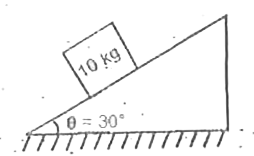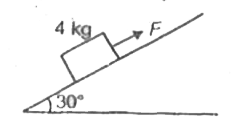A block is kept on a smooth inclined plane of angle of inclination 30∘ that moves with a constant acceleration so that the block does not slide relative to the inclined plane. Let F1 be the the contact force between the block and the plane . Now the inclined plane stops and let F2 be the contact force between the two in this case. Then, F1/F2 is
1
43
2
32
The correct Answer is:B
To solve the problem, we need to analyze the forces acting on a block placed on a smooth inclined plane that is accelerating. We will find the contact forces F1 and F2 in two different scenarios and then calculate the ratio F1F2.
Step 1: Analyze the first scenario (Inclined plane moving with acceleration)
1. Identify forces acting on the block:
- Weight of the block: mg (acting vertically downward).
- Pseudo force due to the acceleration of the inclined plane: ma (acting opposite to the direction of acceleration).
2. Resolve the weight and pseudo force into components:
- The component of weight parallel to the incline: mgsinθ.
- The component of weight perpendicular to the incline: mgcosθ.
- The component of pseudo force parallel to the incline: macosθ.
- The component of pseudo force perpendicular to the incline: masinθ.
3. Set up the equations for equilibrium:
- Along the incline (net force = 0):
macosθ=mgsinθ
- Perpendicular to the incline (net force = 0):
F1=mgcosθ+masinθ
4. Substituting a:
From the first equation, we can express a:
a=gtanθ
Substitute this into the equation for F1:
F1=mgcosθ+m(gtanθ)sinθ
Simplifying:
F1=mgcosθ+mgsin2θcosθ
F1=mg(cosθ+sin2θcosθ)
F1=mg(cos2θ+sin2θcosθ)
Since cos2θ+sin2θ=1:
F1=mgcosθ
Step 2: Analyze the second scenario (Inclined plane at rest)
1. Identify forces acting on the block:
- Weight of the block: mg (acting vertically downward).
- There is no pseudo force since the inclined plane is at rest.
2. Set up the equilibrium equation:
- Perpendicular to the incline:
F2=mgcosθ
Step 3: Calculate the ratio F1F2
1. Substitute the expressions for F1 and F2:
F1F2=mgcosθmgcosθ
Simplifying:
F1F2=1cos2θ
2. Substitute θ=30∘:
cos30∘=√32
Therefore:
F1F2=1(√32)2=134=43
Final Answer:
F1F2=43
- Weight of the block: mg (acting vertically downward).
- Pseudo force due to the acceleration of the inclined plane: ma (acting opposite to the direction of acceleration).
- The component of weight parallel to the incline: mgsinθ.
- The component of weight perpendicular to the incline: mgcosθ.
- The component of pseudo force parallel to the incline: macosθ.
- The component of pseudo force perpendicular to the incline: masinθ.
- Along the incline (net force = 0):
macosθ=mgsinθ
- Perpendicular to the incline (net force = 0):
F1=mgcosθ+masinθ
From the first equation, we can express a:
a=gtanθ
Substitute this into the equation for F1:
F1=mgcosθ+m(gtanθ)sinθ
Simplifying:
F1=mgcosθ+mgsin2θcosθ
F1=mg(cosθ+sin2θcosθ)
F1=mg(cos2θ+sin2θcosθ)
Since cos2θ+sin2θ=1:
F1=mgcosθ
- Weight of the block: mg (acting vertically downward).
- There is no pseudo force since the inclined plane is at rest.
- Perpendicular to the incline:
F2=mgcosθ
F1F2=mgcosθmgcosθ
Simplifying:
F1F2=1cos2θ
cos30∘=√32
Therefore:
F1F2=1(√32)2=134=43
F1F2=43
Similar Questions
A block is kept on a smooth inclined plane of angle of inclination θ that moves wuth a contact acceleration so that the block does not slide relative to the inclined plane. If the inclined plane stops the normal contact force offered by the plane on the block changes by a factor
View SolutionA block of mass 10 kg is kept on a fixed rough (μ=0.8) inclined plane of angle of inclination 30∘. The frictional force acting on the block is

View SolutionA block slides down on inclined plane (angle of inclination 60∘ ) with an accelration g/2 Find the coefficient friction

View SolutionA block slides down a frictionless, inclined plane that makes a 30∘ angle with the horizontal. Find the acceleration of this block.
View SolutionA block of mass 4 kg is pulled along a smooth inclined plane of inclination 30∘ with constant velocity 3 m/s as shown, power delivered by the force is

View SolutionA block of mass m is at rest on a rough inclined plane of angle of inclination θ. If coefficient of friction between the block and the inclined plane is μ, then the minimum value of force along the plane required to move the block on the plane is
View SolutionA block of mass m is placed on a smooth inclined plane of inclination θ with the horizontal. The force exerted by the plane on the block has a magnitude
View SolutionA block of mass m is placed on a smooth inclined plane of inclination θ with the horizontal. The force exerted by the plane on the block has a magnitude
View SolutionA block can slide on a smooth inclined plane of inclination θ kept on the floor of a lift. When the lift is descending with a retardation a , the acceleration of the block relative to the incline is
View SolutionA block can slide on a smooth inclined plane of inclination θ kept on the floor of a lift. When the lift is descending with a retardation a , the acceleration of the block relative to the incline is
View Solution
